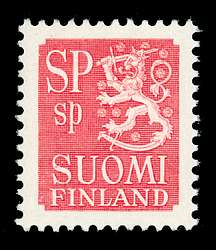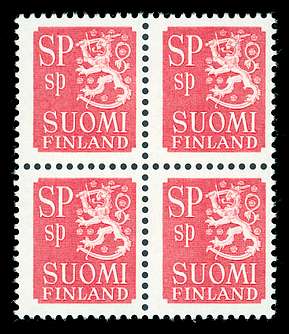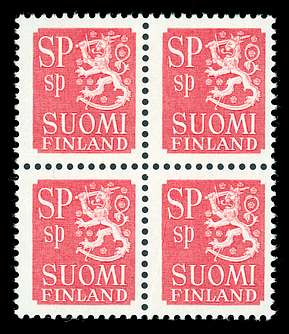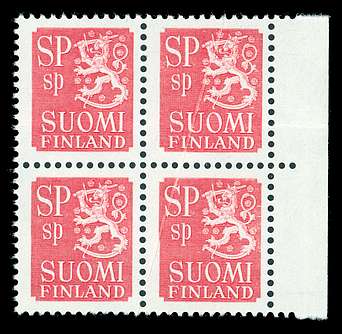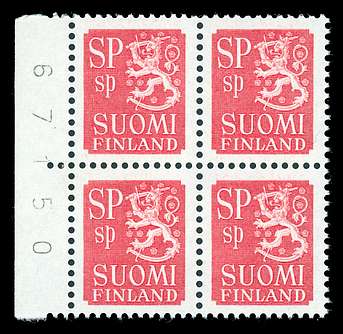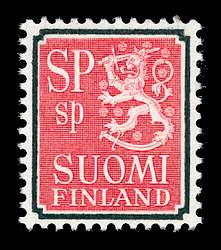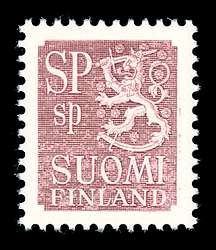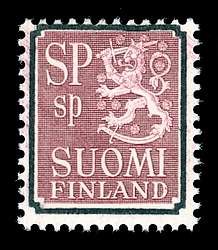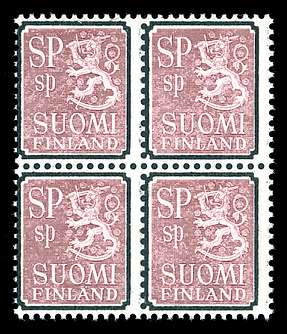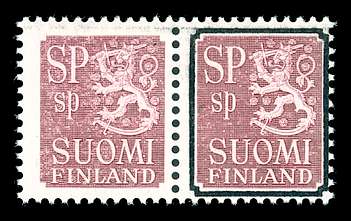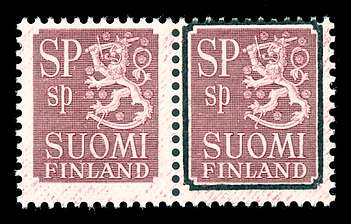Test Stamps (also called Dummy Stamps in the U.S.) are created by stamp printers and post offices to test printing and production processes. While a few test stamps have had extensive philatelic distribution, most were never intended to be distributed or known to collectors and are "scarce" to "rare". New discoveries continue to be made.
All items are available for viewing on approval. I have a constantly changing stock of Finnish and all Scandinavian essays, proofs, reprints, specimens, and test stamps. Most such items sell before they get to the website or price lists. What are you seeking? I am also interested in buying Scandinavian test stamps. |
In preparation for a new 1954 engraved definitive stamp series, utilizing new web recess (engraved) printing presses using plate cylinders, new to Finnish definitive stamps, two designs of test stamps were prepared: Lion and Snellman. I am only aware that these two designs have been recorded, but they each exist in a few different colors/types. These test stamps are "scarce" as singles and are seldom seen in multiples. Though these are usually offered as 1954 test stamps, they were likely printed at least one year before, but I have not found any confirmation of the printing dates.
The Lion Test Stamps have been recorded by me (as of 11/2024) in Red on Thin White Paper and in Mauve (Lilac) on Thick Bright White Paper. Both are perforated 11.75 on all sides. Based on observed multiples, at least one test plate/cylinder was 12 stamps wide. All (?) or most of the time (?), the center 6 stamps were additionally printed with a black border. [The circumference of the plate / number of stamps printed per rotation of the plate is not known to me.] The printing method for the black border is probably lithography (offset), but sometimes has the general appearance of typography (letterpress). [The purpose of the black border was likely to prove the printing press capability -- or lack thereof -- of achieving close register of a lithography color in combination with an engraved color.]
There are thus four basic single stamps possible: the two colors plus those colors with the additional black border. Additionally, one can find horizontal pairs of the without- and with-border stamps AND pairs of the with- and without-border stamps, thus, with the two colors, there are four pairs possible.
The centering of both the Red and Mauve stamps varies considerably, with Fine or F-VF being typical and VF being "scarce". It appears that this was caused by a mismatch between the size and spacing of the stamps and the size/spacing of the perforating tool columns and rows. [Web-wide multiples that I viewed in 1987 demonstrated that the centering may have started out better or worse on one side, but the centering progressively changed for better or worse, across the width of the web.]
The Red stamps that I have observed (as of 11/2024) have uniformly excellent printing quality. However, almost all the Mauve stamps that I have observed (as of 11/2024) have an irregular printing appearance as if there was a problem with ink transfer to the plate and/or ink transfer and adherence to the paper (both of which can have a variety of causes) -- this has to be considered to be normal for the Mauve stamps and is not a defect.
On the Red stamps, the left and right sheet margins that I have observed (as of 11/2024) are 9-10 mm wide. On the Mauve stamps, the left and right sheet margins that I have observed (as of 11/2024) are 23-25 mm wide. For both colors, I have NOT recorded (as of 11/2024) any examples with top or bottom sheet margins, which suggests that the plate printed a continuous "web" of stamps that would have to have been cut apart. However, I have NOT recorded (as of 11/2024) any stamps with straight-edges or straight-cut-perfs at top or bottom. [A typical application for this continuous format would be to print booklet panes which were to be subsequently cut by machine.] For both colors, I have recorded (as of 11/2024) in the left sheet margins 5-digit serial numbers in the 60,000 range; these numbers were probably incremented with every revolution of the plate cylinder.
If you include these Lion Test Stamps in your collection and are seeking any of the four single stamps or four pairs, or other items such as multiples and margin examples, please let me know both what you have and what you are seeking. I maintain records and will be happy to assist you in building your collection. |
